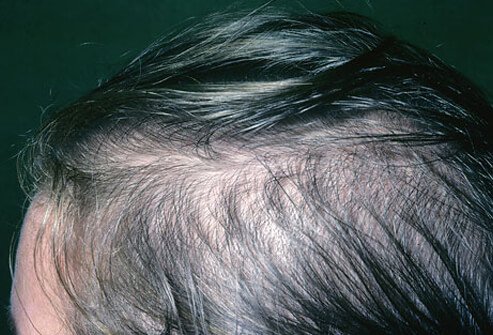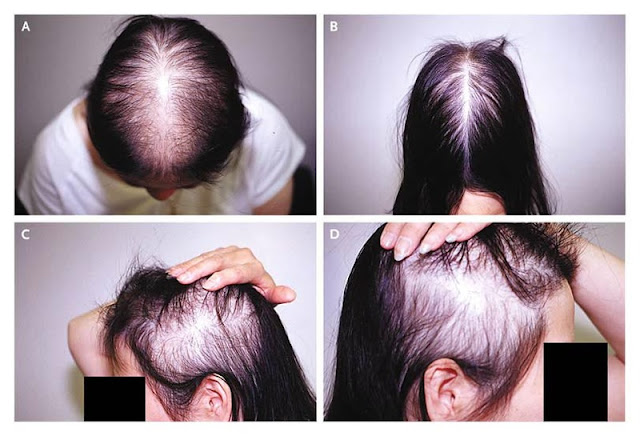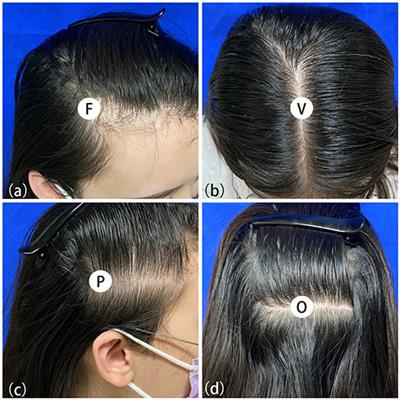WHAT IS HAIR LOSS?CAUSES, WHAT IS MAIN REASON OF HAIR LOSS IN FEMALES?HAIR LOSS CAN BE CURED?FRONT HAIR LOSS IN FEMALES, DIET, TREATMENT
It is common to lose a certain amount of hair every day. People usually lose 100 hairs every day.
If a person notices that their hair is falling out more than normal, they may have an underlying condition. In that case, they should see a doctor and seek advice on what are the best treatment options.
In many cases, a person's hair returns to its normal state after being treated by a doctor for the underlying condition.
HAIR LOSS DEF:
CAUSES
MAIN REASON OF HAIR LOSS IN WOMEN
HAIR LOSS CAN BE CURED?
FRONTAL FEMALES HAIR LOSS
WHICH VITAMIN DEFICIENCY CAUSE HAIR LOSS
TREATMENT
WHAT IS HAIR LOSS / DEF:
Hair loss usually refers to partial or total loss of hair from the growing body, especially from the scalp. Alopecia is the medical term for baldness, which is the loss of hair or a significant part of the scalp. Unlike other parts of the body, hair is mostly decorative. Hair loss is not a medical problem, but in some cases it can be a sign of illness. Going bald is completely comfortable for most people. However, others will find that hair fall is less attractive.
DIFFERENCE BETWEEN ALOPECEA AND HAIR LOSS:
Hair loss:
Can be considered normal in the sense that it is very common. However, hair falling does not happen for no reason. There are special conditions for a person to experience hair fall.
Do not confuse with hair loss, in which we naturally lose hair loss on a daily basis. Hair loss is the loss of a significant amount of hair due to various reasons. Those causes include heredity, reactions to certain toxins, hair care products with harsh ingredients and even certain types of hairstyles that can cause hair to fall out.
Whatever the cause of hair loss, the only way to prevent or reverse it is to correct the underlying problem. Once this is fixed, the hair will begin to grow back naturally.
Awareness Alopecia:
So what is alopecia? Technically, alopecia is the medical term for hair loss. So anyone who experiences any type of hair loss will actually have alopecia. However, there are various forms of alopecia that can be considered serious conditions that require treatment.
Types of alopecia / Hair loss
1. Male / female specimen bald
Due to this type of alopecia, the hair starts to fall out on the head, which can lead to baldness.
2. Alopecia areata
Alopecia areata occurs very suddenly (several days to a week) and appears as many circular bald patches on the scalp.
3. Alopecia Universalis
This condition causes hair to fall out on all parts of the body.
4. Alopecia Totalis
Alopecia Totalis is a condition in which a person loses all the hair on their head.
CAUSES OF HAIR LOSS
More than 40 million men and 20 million women in the United States have hair loss. It is very common for both men and women to have thinning hair on their head as they age. However, hair loss can occur for many other reasons. Some forms of hair loss and their causes.
Common Causes Are:
Hairstyle:
Tight ponytails, braids or cornices can cause your hair to fall out when your hair is styled to look like your roots. This type of hair loss is called traction alopecia. If the hair follicles are damaged, the damage is permanent.
Vitamin deficiency.
Dieting (rapid weight loss).
Compulsory diet.
Over-processed scalp hair (breakage).
What major causes hair loss?
Toxic substances including chemotherapy, radiation therapy and some medications. These can cause sudden hair fall that can occur anywhere on your body. This happens with the hair during the growth phase. Sometimes, this type of hair fall can be permanent if your hair follicles are damaged.
What causes telogen effluvium hair loss?
Excessive physical stress or shock to your body: It can cause temporary hair loss. This category includes events such as weight loss, surgery, anemia, illness and childbirth.
Severe mental stress: mental illness, death of a loved one, etc.
Abnormal thyroid.
Medications and Medications: High doses of antihypertensive drugs, arthritis medications and vitamin A.
Hormonal changes caused by pregnancy, menopause or birth control pills.
Hereditary hair fall
Both men and women develop this type of hair loss, which is the most common cause of hair loss worldwide. In men, this is called male pattern hair loss. Women have female pattern hair fall.
Alopecia areata
Alopecia areata develops when the body's immune system attacks hair follicles (causing hair to fall out), causing hair to fall out.
Hormonal imbalance
A common cause of this imbalance is polycystic syndrome (PCOS). It can cause hair loss, along with cysts, other signs and symptoms on the female ovaries.
Skin infection:
Scalp infections can cause scalp and sometimes inflammation on your scalp. You can see how small black dots are on your scalp. These are actually the stubbornness of the hair. Some people develop bald spots.
Drug:
Hair loss is a side effect of some drugs. If you think a hair lotion can cause your hair to fall out, ask your doctor if hair loss is a side effect. It is very important that you stop taking the medicine before talking to your doctor. Sudden cessation of certain medications can lead to serious health problems.
Female-pattern baldness:
It’s not just men who lose hair. As men begin to lose forehead hair, women begin to see hair falling on the top of the head and the top of the head. As in men, it may be related to genetics (family history) and is more common after menopause. Unlike in men, hair fall is not total and hair before hair fall is usually not affected before.
MAIN SYMPTOMS OF HAIR FALL:
Men often start losing hair from the forehead..
Female-pattern baldness (alopecia areata) is sometimes itchy or painful scalp.
Patchy Hair Loss (Alopecia Areta)
Repeatedly on the hair can cause a type of hair loss called traction alopecia
Traction Alopecia
Menopausal women experience frontal fibrosing alopecia, which causes hair loss.
Hair loss can be expressed in many ways depending on its cause. It comes on suddenly or gradually and affects your scalp or your entire body.
Signs and symptoms of hair loss may include:
Gradually thinning on the head. Hair loss is a very common type that affects people of all ages. Men often have hair falling out at the hair on the forehead. Women usually have extensions in their hair. Decreased normal hair fall in older women (frontal fibrosing alopecia).Scaling patches spreading on the scalp:
This is a symptom of ringworm.
This can lead to broken hair, redness, swelling, and sometimes, seasickness.
Hypothyroidism
can cause anything from fatigue to weight gain, muscle weakness to inflammation of the joints.
Celiac disease can cause anything from mouth ulcers to headaches, skin rashes to anemia.
Hodgkins disease
causes symptoms such as fever, night sweats and swollen lymph nodes.
Your doctor will consider other symptoms you may be experiencing in addition to hair loss. It can range from a physical exam to a blood test to a skin biopsy.
Certain conditions, such as celiac disease, can be genetically inherited. If you have a family history of a condition that can lead to hair loss, be sure to tell your doctor.
Menopause and hormonal imbalances
Women experience hair loss during menopause due to decreased production of the hormones estrogen and progesterone. These changes can also lead to symptoms such as structural cycle manipulations, dry skin, night sweats, weight gain and vaginal dryness. This extra pressure on the body also exacerbates hair loss.
Birth Control Pills:
Some women may also notice thinning and loss after taking hormonal birth control pills. any kind of hormonal change, especially falling estrogen levels, can temporarily disrupt the life cycle of the hair.
FRONT HAIR / PATTERN LOSS IN FEMALES:
What is female pattern hair fall?
Female pattern hair loss (FPHL) is a specific form of hair loss that occurs in women with androgenetic alopecia. Many women suffer from FPHL. By the age of 50, 40% of women show signs of hair loss and less than 45% of women reach the age of 80 with full head hair.
In FPHL, scalp hair thinning occurs due to hair loss or hair size reduction or both. It is common to lose 50-100 hairs in a day. Another condition known as chronic telogen effluvium increases hair fall and is often confused with FPHL. It is important to distinguish between these conditions because the management of the two conditions is different.
FPHL is very different from the more easily recognizable male pattern baldness, which usually decreases with the frontal hairline developing up to a bald patch on the top of the head. Unless the production of androgens in the body is high, it is very uncommon for women to become bald following the male pattern.
DIAGNOSIS FOR HAIR FALL:
Biopsy of
In this test, a small part of the scalp is examined under a microscope after removing it from your head. It helps to know the cause of your hair loss.
So, these are the test which you can go through in case of experiencing excessive hair loss.
Suggested Diagnosis and Tests for Hair Loss
HAIR LOSS TREATMENT:
- Liquid, foam and oil treatments:
- Shampoo hair loss remedies:
- The hair masks:
- Minoxidil:
Minoxidil, the most effective active ingredient in topical hair loss treatments for women, is the only substance approved by the Food and Drug Administration (FDA) for the treatment of female-pattern baldness. It is usually available in liquid or foam form, which is massaged directly into the scalp.
Minoxidil helps regenerate by regenerating folded follicles. It usually works best in women with hair loss or short hair patches. must use it indefinitely.
- Green tea:
If you like the non-minoxidil product, green tea is often an effective ingredient in hair loss treatments. Studies show that they help reduce the levels of DHT, which can cause hair loss. Its anti-inflammatory properties are believed to stimulate hair growth.
- Redensyl:
This is another common ingredient in hair loss treatments that activate the hair follicles and stimulate new growth.
- Antimicrobial:
If a fungal infection or itchy skin causes your hair to fall out, products containing tea tree oil, ketoconazole, lavender and other antimicrobial ingredients can help.
- Strengtheners:
Some hair loss treatments also contain ingredients that help strengthen the hair to prevent hair breakage that can lead to hair loss. Biotin, panthenol, retinol, aloe vera and argan oil all work well.
Homeopathic medicine for hair loss:
1. Thuja Occidentalis:
Thuja is the best remedy for hair loss due to dry, white, scaly dandruff. This remedy is indicated for dry hair and thinning hair. It helps in hair growth and makes them shiny.
2. Natrum muriaticum:
Natrum muriaticum works well when you experience hair loss after childbirth. In such cases, hair fall starts from the frontal area of your head (Bregma). It is also indicated for women suffering from hair loss due to anemia (iron deficiency).
3. Lycopodium:
Lycopodium is effective for hair loss after childbirth, menopause or ovarian dysfunction. This is also indicated when hair fall is first observed from the scalp, followed by graying of the hair at the temples.
4. Fluoric acid:
Fluoric acid is one of the best homeopathic remedies for hair loss and is highly recommended in treating patients with hair loss (alopecia areata). Fluoric acid helps hair regrowth. It also helps a lot in hair loss after a fever like typhoid. This is indicated when the hair is dry, easily entangled and broken.
5. Phosphorus:
This medicine is recommended when hair loss appears in the inflorescences. The hair becomes dry and gray, resulting in hair falling from the top, crown area and forehead. It is also effective for hair loss due to water changes, climate change and dandruff.
There are many other homeopathic remedies for hair loss such as sepia, lachesis, sulfur, graphite, phosphoric acid which help in controlling hair loss and promoting hair growth.
Always use homoeopathy medicines after complete symptoms and doctor's advise.
For more health related information, visit my channel.













4 Comments
👍👍👍👌👌👌
ReplyDeleteDR zbrdst infrmation dee apny thnkxxx Dr shiba
ReplyDeleteZBRDST Zbrdst Dr tayyiba thnkxx bhoot bhoot 4 shring
ReplyDeleteGreat👍👍👍👍
ReplyDelete